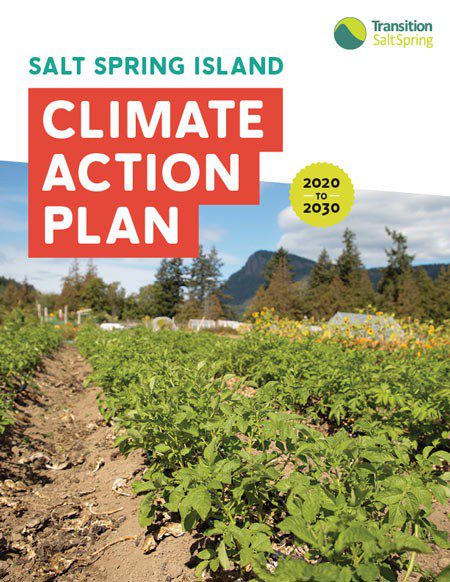Transportation emissions are a major contributor to the global climate crisis.
For Salt Spring Island, transportation is the biggest source of direct emissions (food is the highest source of indirect emissions). Local transportation includes private automobiles, commercial vehicles and buses, floatplanes, BC ferries, and other marine vessels. When these sources are added to the emissions associated with the transport of imported goods, visitors, and off-island travel by islanders — including long-distance flights and cruises — transportation likely represents our biggest direct opportunity for emissions reductions.
Salt Spring Island is well-positioned to become a leader as an all-electric, transit-oriented, active-transportation community with all the attendant health, safety, and economic benefits and opportunities.
Two key focuses in the Climate Action Plan 2.0 for transportation are:
- to reduce annual emissions by 68% from 49 000 tonnes in 2018 to 19 000 tonnes in 2030.
- to develop mobility alternatives that promote healthy living and increased accessibility.
Resources, News & Events
Earth Day Bike Ride with Adam Olsen
BC Releases Climate Preparedness and Adaptation Strategy
Let’s Get There Green! Video
What Salt Spring Can Do
The benefits of electrification and active transportation go well beyond reducing transportation GHG emissions: increased exercise from cycling and walking improves mental and physical health and reduces health care costs, whereas exposure to fossil-fuel vehicle exhaust is implicated in a number of medical conditions. More public transit improves quality of life and reduces the need for owning a vehicle and the associated costs. Implementing these recommendations expands potential business opportunities and job creation for new and existing businesses. Transportation is closely linked to land use planning, especially in a comprehensive village planning program. Related recommendations are in the Climate Action Plan for Built Infrastructure and Land Use sections.
The priorities for the next ten years are to:
- Electrify the majority of vehicle types.
- Reduce emissions from the remaining fossil-fuel vehicles.
- Expand public transit service.
- Make it easier to get around the island on foot, by bicycle, and by mobility scooter.
Success Stories
The Salt Spring community is highly dependent on private vehicles to get around. There are almost as many vehicles registered here as islanders — over 10,000 registered vehicles in 2018 and 11,300 people — not including the vehicles brought by thousands of visitors in summer months. Since 2011, a number of steps have been taken to reduce transportation GHG emissions on Salt Spring.
Examples include:
- More routes and service on the Salt Spring Island Transit System, with over 117,000 riders in 2019.
- More bicycle use (including electric bikes), more bike racks, and 10 public e-bike charging outlets.
- More pedestrian pathways built or planned — about five kilometres exist today.
- Rapid growth of electric vehicles (EVs) from 4 in 2011 to more than 270 in 2020, and 12 free public EV charging stations installed with 18 charging wands (14 J1772 & 4 Tesla), reducing GHG emissions by over 1,000 tonnes/year. More EV charging stations and wands are in the planning stages.
- BC Ferries replaced the Queen of Nanaimo with the more fuel-efficient Salish class vessels, and a new series of hybrid electric ferries is coming into service.
- Land use planning policies that have concentrated more new development and community buildings in existing centres and near transit routes.
- Harbour Air’s seaplane electrification program.
These achievements are important and lay the groundwork for future change.




